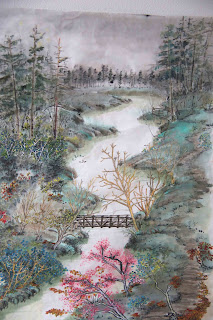Chinese calligraphy is sometimes recognized as the highest visual art form in Chinese art. It is the foundation governing the use of the Chinese brush. I have been told that a good calligrapher can evolve to be a good painter with relative ease, but a person naive to calligraphy could never be a good painter.
I practise calligraphy not only to hone my skills with the brush, but because this was something ingrained into my upbringing long time ago. Calligraphy was taught as part of the curriculum, even at the primary school level. I now regret that I did not pay close attention to it during my formative years. I blame this on the absence of inspiring teachers.
My current calligraphy teacher wanted me to do the grass script calligraphy. My teacher proposed a therapeutic goal of opening me up and allowing me to be more open and expressive. I have read books on handwriting analysis; on how personality can be revealed by the manner a person crosses the T's and dots the I's. This is a novel idea to employ calligraphy as a tool to modify personality.
Instinct told me that the grass script is the hurried style, when the person was writing in a hurry and the strokes were simplified and also became connected between characters. This impression was supported by the amount of voids or empty streaks in the brush stroke, hinting fast brush speed on the paper, and the thin silk like brush strokes, again hinting speed and haste. This style is carefree and elegant to me, all at the same time.
I tried writing them fast and furious. I tried to write them standing up in my kung fu stands and using my hips and shoulders to effect change of directions. I tried using dry brush so it was easier to lay down streaks. I tried using a very stiff, almost wire brush like tufted brush to achieve better transmittal of strength from my body onto the paper. I tried to gyrate and tilt my brush laterally to an acute angle, to obtain the sharp edge so I can demonstrate the fine corn silk like threads.
Boy was I wrong. I have never been so far from the truth. I was so misguided in my assessment that it wasn't even funny, especially to my calligraphy teacher.
Despite the appearance of hasty cursive, I still needed to start slow and steady. The form and energy lied within the proper execution of the brushstrokes and not merely the apparent shape. The empty streaks were happy accidents and not from purposed manufacturing. The thin threads were from natural lifting and the desire of the mind to go to the next character. Thus my kung fun stands and using wire brush and tilting the brush amounts to a cartoonish tracing and not "writing". I was engaged in theatrics. I was being superficial and ostentatious.

And this is so true. More often than not, we were so consumed by gingerly trying to form the perfect image that we either forgot or were unable to comprehend what is important at hand. We forgot what we must do to get there. When we look at the photography of a prancing antelope we saw the grace and agility, but we forgot that was just one moment captured by the shutter. There was the running, the recoiling of the legs, the arching of the back, the extension of the body and neck. Everything happened in a fluid continuum and not as discrete micro movements. Despite the best craftsman, mannequins are just that; and the figures in the best wax museum are only life-like, but do not exude life. I was trying so hard to imitate each brushstroke, each character, that I lost sight of the flow and the narration of the script. I was trying to create a quantum leap of a prancing anetlope from one that stood still.
So my calligraphy teacher demonstrated by writing just 2 characters. They looked nothing like the original Te. There were no thin threads, no streaking brush strokes. Yet there was the palpable grace and energy which conformed with the grass style script.
After the benevolent brow-beating, I learned to look at the grass style writing in new light. I settled down and concentrated not so much on the shapes and nuances but on the brush strokes themselves.
It became apparent that even the strokes seemed hurried, they still needed to be extended fully before changing directions. It was analogous to snapping a wet towel or cracking a whip. The tip needed to travel all the way until it was fully extended before snapping back, thus getting that extra leverage to deliver that sting.
I also became more lucid about the delivery of the brush strokes. I gave myself permission to be free from copying every single brush stroke, but to feel the whole string of characters. Pretty soon a natural rhythm was starting to take shape. Some characters felt better if the continuation is through several change of directions, while others could be just one stroke. There is a cadence to this dancing of the brush. I call this the arpeggios in brush strokes. It is true that the arpeggio consists of progression of notes, but we play them as a fluid string rather than segmented stops. And then when we get good enough, we can impart color and character to individual notes even in a legato. In fact calligraphy is not unlike bowing. There is the frog, the tip, up bow and down bow, much like the belly, the tip and brush travel in various directions. There are musical passages requiring successive down bows or up bows, or expressive frog to tip, or several bows to make one seamless note. The pressure, speed and placement of the bow has to come from within, and not manufactured from a set of instructions.

There is hope for me. Yet.




















